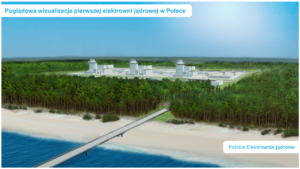PGNiG is very competent at storing and distributing gas, including hydrogen. Nevertheless, we are researching the whole cycle – from production to usage in transport – to learn about the entire chain – Arkadiusz Sekściński, PGNiG’s Vice-President of the Management Board responsible for development, said in an interview with BiznesAlert.pl.
BiznesAlert.pl: At what stage of implementation are the projects from PGNiG’s hydrogen strategy?
Arkadiusz Sekściński: We announced our hydrogen program in May 2020. It includes five projects. At this point their budget is PLN 40 million. However, this program is still growing and new projects are being initiated and planned.
At this moment our key focus is the „InGrid-Power to Gas” venture. Its goal is to verify the possibilities of transferring and storing hydrogen across the gas grid. We want to build a complete installation for generating hydrogen from renewable energy on our premises in Odolanów. We will then pump this fuel into a closed gas grid for research. Gazoprojekt, a company that is part of the PGNiG group, prepared a feasability study for the project. According to the endeavor’s schedule, the research facilities will be built by the end of 2022.
Why is this project PGNiG’s most important hydrogen enterprise?
We want to become specialists in hydrogen transmission and storage. Since our group owns an operator of a distribution network and an operator of a gas storage system, we believe we may have a significant competitive advantage when it comes to developing a successful hydrogen strategy. The investment in Odolanów will, among others, allow us to verify how much hydrogen can be mixed in with gas to ensure safe transport via the gas grid. Data from various countries show different numbers with regard to this problem. According to research conducted in Leeds, Great Britain, that figure may be even at 20 percent, in Holland only 0.5 percent is mixed in, while the literature on the subject says that a safe level is between 4 and 8 percent. Our research will test mixtures that include between 1 and 23 percent of hydrogen.
At the same time, since hydrogen can be injected into cavern gas storage facilities, it may be used to store large amounts of power generated from renewable energy sources. Offshore wind farms on the Baltic will generate plenty of power, also at night, so at times there will power surpluses. We can use them to produce hydrogen in the process of electrolysis, and then pump the generated gas into storage to use in transportation, the energy sector or re-convert it to electricity. We want to make hydrogen storage a service that is offered by the PGNiG Group. This is why Gas Storage Poland, which operates the storage system, launched research into this topic. Natural gas is a well-known fuel, but hydrogen still needs more scrutiny. The research facility is our first step, but the goal is to offer a commercial service.
Are you considering using hydrogen for transport?
Our hydrogen strategy includes a project related to transport. It was launched in 2019, and in April 2020 we signed an agreement with a Polish-British consortium that develops hydrogen fueling stations. Currently we are working on acquiring the mandatory administrative permits. To make this project as valuable as possible, we invited Toyota to participate. According to our agreement with Toyota, the company will deliver cars, engineering support and know-how to verify the safety of fuelling its vehicles and to determine technical challenges, etc.
Another crucial element of our strategy is to expand our analytical competencies. PGNiG owns the Central Measurement and Testing Laboratory, which is now focusing on natural gas research. We want to increase the lab’s scope by adding, among others, research on gas mixtures to learn about the proportions in which gas mixing is feasable, e.g. natural gas and hydrogen, as well as to analyze hydrogen purity, as it determines to what ends the gas may be used.
The hydrogen program will grow. The generation of blue hydrogen is also high on our agenda. That kind of hydrogen is produced from natural gas and is accompanied by CO2 emissions. We should not forget about it, because it is a stepping stone to the green hydrogen, which is the most desirable one.
Does PGNiG’s strategy include a proportion of green vs blue hydrogen generation?
No, we don’t have any fixed proportions. Also, PGNiG is after specializing specifically in hydrogen distribution and storage. Hydrogen generation may be pursued by other companies, including the petrochemical, refinery, chemical and energy sectors. As a gas company our advantage lies in our cavern gas storage facilities and our gas grid. When it comes to production, our engagement is about research, which will allow us to learn about the entire mechanism, the whole chain of the hydrogen industry.
Does PGNiG’s hydrogen strategy correspond with Poland’s future hydrogen strategy, that is to be revealed at the beginning of November?
This is an important question, because every business operates within an institutional and regulatory framework of a given country. So far, we are familiar only with the EU’s hydrogen strategy, and we know that it puts emphasis on green hydrogen, which means the biggest subsidies will go to that end. Together with the government we are calling on the EU very loudly to not forget about grey and blue hydrogen. We are hoping that the Polish hydrogen strategy will encompass not only hydrogen generation or its usage in transport and the energy sector, but also the important issue of storage and transportation.
Interview by Mariusz Marszałkowski









